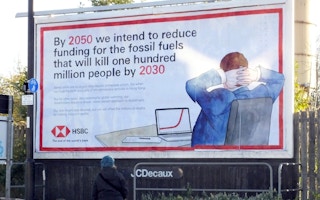HSBC has launched a new policy that will curtail the financing of oil, gas and associated power plants and utilities this decade. It is the first time the British lender has committed to such a target which it says is a key interim step towards achieving its goal of net-zero financed greenhouse gas emissions by 2050.
To continue reading, subscribe to Eco‑Business.
There's something for everyone. We offer a range of subscription plans.
- Access our stories and receive our Insights Weekly newsletter with the free EB Member plan.
- Unlock unlimited access to our content and archive with EB Circle.
- Publish your content with EB Premium.
The policy, published on Tuesday with the bank’s annual report, commits to a 34 per cent reduction in financing oil and gas clients currently on its balance sheet by 2030. The company says this will mean a drop from 35.8 million tonnes of carbon dioxide equivalent (Mt CO2e) to 23.5 million tonnes over the next eight years.
The bank also committed to a 75 per cent reduction in emissions intensity for the power and utilities sector this decade.
It said these new targets are aligned with the net-zero emissions pathway set by the International Energy Agency (IEA) to limit global warming to within 1.5°C by the end of the century.
HSBC is one of the first banks to set interim targets as it guns for net-zero emissions by 2050. It is part of the Net Zero Banking Alliance, a club of more than 100 banks that have commited to mid-century carbon neutrality.
HSBC’s chief sustainability officer Celine Herweijer said that the bank’s 2030 targets will be “embedded into business decision-making” and signals to customers the level of decarbonisation needed over the coming years.
“We want to support those who take an active role in the energy transition; this is where we can have the greatest impact in making net zero a reality,” she said in a statement.
Market Forces, an environmental group, said that HSBC’s new targets are a “con”, because they contained loopholes by applying the target only to ‘on-balance sheet’ emissions. The policy will also enable the bank to continue to finance new oil and gas projects, it added.
The targets can be met through accounting techniques and selling debt on secondary markets that moves exposure off HSBC’s balance sheet instead of restricting oil and gas financing, Market Forces said.
“We have to congratulate HSBC for finding a new and innovative way to fudge their emission reduction targets,” said Adam McGibbon, UK campaign lead at Market Forces. “This target means HSBC can finance the oil and gas industry to its cold, ashened heart’s content and all it needs to do to meet its target is shift enough of that debt off its balance sheet.”
An HSBC spokesperson declined to respond to Market Forces’ comments, referring Eco-Business to the company’s “commitment in helping clients develop science-based transition plans to achieve an effective transition.”
A study published last week by ShareAction, a campaign group, found that HSBC has funded the upstream oil and gas sector more than any other European bank since the signing of the Paris climate accord; US$5.9 billion between 2016 and 2021.
The bank announced a plan to phase-out thermal coal lending in wealthy countries by 2030 and the rest of the world by 2040 in December last year. HSBC also said on Tuesday targets for the coal, aluminium, cement, iron, steel and transport sectors would follow in 2023.










